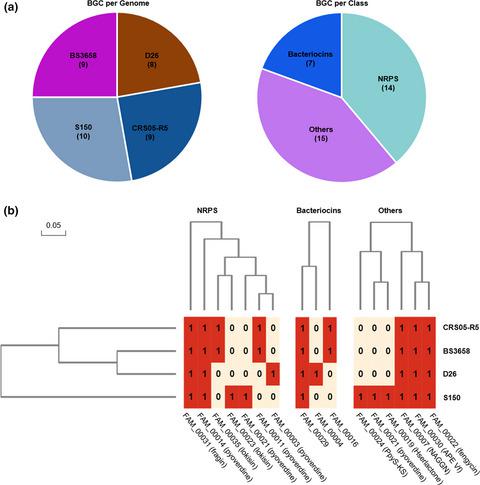当前位置:
X-MOL 学术
›
Microbiologyopen
›
论文详情
Our official English website, www.x-mol.net, welcomes your
feedback! (Note: you will need to create a separate account there.)
Genomic insights into a plant growth-promoting Pseudomonas koreensis strain with cyclic lipopeptide-mediated antifungal activity.
MicrobiologyOpen ( IF 3.9 ) Pub Date : 2020-06-15 , DOI: 10.1002/mbo3.1092 Yilin Gu 1 , Yi-Nan Ma 1 , Jing Wang 1 , Zhenyuan Xia 2 , Hai-Lei Wei 1
MicrobiologyOpen ( IF 3.9 ) Pub Date : 2020-06-15 , DOI: 10.1002/mbo3.1092 Yilin Gu 1 , Yi-Nan Ma 1 , Jing Wang 1 , Zhenyuan Xia 2 , Hai-Lei Wei 1
Affiliation

|
Strain S150 was isolated from the tobacco rhizosphere as a plant growth‐promoting rhizobacterium. It increased plant fresh weight significantly and lateral root development, and it antagonized plant pathogenic fungi but not phytobacteria. Further tests showed that strain S150 solubilized organic phosphate and produced ammonia, siderophore, protease, amylase, and cellulase, but it did not produce indole‐3‐acetic acid. Using morphology, physiological characteristics, and multi‐locus sequence analysis, strain S150 was identified as Pseudomonas koreensis. The complete genome of strain S150 was sequenced, and it showed a single circular chromosome of 6,304,843 bp with a 61.09% G + C content. The bacterial genome contained 5,454 predicted genes that occupied 87.7% of the genome. Venn diagrams of the identified orthologous clusters of P. koreensis S150 with the other three sequenced P. koreensis strains revealed up to 4,167 homologous gene clusters that were shared among them, and 21 orthologous clusters were only present in the genome of strain S150. Genome mining of the bacterium P. koreensis S150 showed that the strain possessed 10 biosynthetic gene clusters for secondary metabolites, which included four clusters of non‐ribosomal peptide synthetases (NRPSs) involved in the biosynthesis of cyclic lipopeptides (CLPs). One of the NRPSs possibly encoded lokisin, a cyclic lipopeptide produced by fluorescent Pseudomonas. Genomic mutation of the lokA gene, which is one of the three structural NRPS genes for lokisin in strain S150, led to a deficiency in fungal antagonism that could be restored fully by gene complementation. The results suggested that P. koreensis S150 is a novel plant growth‐promoting agent with specific cyclic lipopeptides and contains a lokisin‐encoding gene cluster that is dominant against plant fungal pathogens.
中文翻译:

对具有环状脂肽介导的抗真菌活性的植物生长促进韩国假单胞菌菌株的基因组见解。
菌株 S150 是从烟草根际分离出来的,是一种促进植物根际生长的细菌。它显着增加植物鲜重和侧根发育,并且拮抗植物病原真菌但不拮抗植物细菌。进一步测试表明,菌株S150溶解有机磷酸盐并产生氨、铁载体、蛋白酶、淀粉酶和纤维素酶,但不产生吲哚-3-乙酸。通过形态学、生理学特征和多位点序列分析,菌株S150被鉴定为朝鲜假单胞菌。对菌株S150全基因组进行测序,显示单条环状染色体,长度为6,304,843 bp,G+C含量为61.09%。细菌基因组包含5,454个预测基因,占基因组的87.7%。已鉴定的朝鲜P. koreensis S150与其他三个已测序菌株的直系同源基因簇的维恩图显示,它们之间共有多达 4,167 个同源基因簇,其中 21 个直系同源基因簇仅存在于菌株 S150 的基因组中。对韩国P. koreensis S150 细菌的基因组挖掘表明,该菌株拥有 10 个次生代谢物生物合成基因簇,其中包括 4 个参与环脂肽(CLP)生物合成的非核糖体肽合成酶(NRPS)簇。其中一个 NRPS 可能编码 Lokisin,一种由荧光假单胞菌产生的环状脂肽。 lokA基因是菌株 S150 中 lokisin 的三个结构 NRPS 基因之一,其基因组突变导致了真菌拮抗作用的缺陷,而这种缺陷可以通过基因互补来完全恢复。结果表明, P. koreensis S150 是一种新型植物生长促进剂,具有特定的环状脂肽,并含有一个 Lokisin 编码基因簇,该基因簇对植物真菌病原体具有优势。
更新日期:2020-06-15
中文翻译:

对具有环状脂肽介导的抗真菌活性的植物生长促进韩国假单胞菌菌株的基因组见解。
菌株 S150 是从烟草根际分离出来的,是一种促进植物根际生长的细菌。它显着增加植物鲜重和侧根发育,并且拮抗植物病原真菌但不拮抗植物细菌。进一步测试表明,菌株S150溶解有机磷酸盐并产生氨、铁载体、蛋白酶、淀粉酶和纤维素酶,但不产生吲哚-3-乙酸。通过形态学、生理学特征和多位点序列分析,菌株S150被鉴定为朝鲜假单胞菌。对菌株S150全基因组进行测序,显示单条环状染色体,长度为6,304,843 bp,G+C含量为61.09%。细菌基因组包含5,454个预测基因,占基因组的87.7%。已鉴定的朝鲜P. koreensis S150与其他三个已测序菌株的直系同源基因簇的维恩图显示,它们之间共有多达 4,167 个同源基因簇,其中 21 个直系同源基因簇仅存在于菌株 S150 的基因组中。对韩国P. koreensis S150 细菌的基因组挖掘表明,该菌株拥有 10 个次生代谢物生物合成基因簇,其中包括 4 个参与环脂肽(CLP)生物合成的非核糖体肽合成酶(NRPS)簇。其中一个 NRPS 可能编码 Lokisin,一种由荧光假单胞菌产生的环状脂肽。 lokA基因是菌株 S150 中 lokisin 的三个结构 NRPS 基因之一,其基因组突变导致了真菌拮抗作用的缺陷,而这种缺陷可以通过基因互补来完全恢复。结果表明, P. koreensis S150 是一种新型植物生长促进剂,具有特定的环状脂肽,并含有一个 Lokisin 编码基因簇,该基因簇对植物真菌病原体具有优势。











































 京公网安备 11010802027423号
京公网安备 11010802027423号